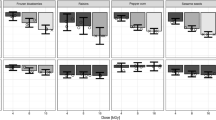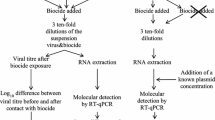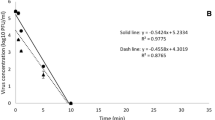Abstract
The objectives of this study were to determine the role of microbial activity in inactivation of hepatitis A virus (HAV) and to learn how the virus is inactivated. Of 31 bacterial strains isolated from animal manure, 10 efficiently inactivated HAV in fluid thioglycollate medium, with D10 values (time, in days, required for a 90% reduction of virus titer) of ≤ 10 at 30°C. The D10 value of the control suspension without bacteria was 35.1. Most of the 10 strains raised the pH of the medium during growth; comparisons suggested that alkalinity was not a principal antiviral property of these cultures. Cell-free filtrates of nine of these strains caused net 90% inactivation of HAV within 6 days at 37°C; the other did not. The inactivation capacity of four of the nine culture filtrates was significantly reduced by incubation with selected protease inhibitors before the virus was added. These protease inhibitors did not affect the activities of the other five culture filtrates. Fractions prepared by ultrafiltration (nominal molecular weights <1,000) from two of these cultures inactivated HAV suggesting that their mode of action was not enzymatic.
Similar content being viewed by others
References
Clesceri LS, Greenberg AE, Trussell RR (1989) Standard methods for the examination of water and wastewater, 17th ed. American Public Health Association, Washington, D.C., pp 2–73
Cliver DO, Herrmann JE (1972) Proteolytic and microbial inactivation of enteroviruses. Water Res 6:797–805
Deng MY, Cliver DO (1992) Inactivation of poliovirus type 1 in mixed human and swine wastes and by bacteria from swine manure. Appl Environ Microbiol 58:2016–2021
Deng MY, Cliver DO (1995) Persistence of inoculated hepatitis A virus in mixed human and animal wastes. Appl Environ Microbiol 61:87–91
Deng MY, Day SP, Cliver DO (1994) Detection of hepatitis A virus in environmental samples by antigen-capture PCR. Appl Environ Microbiol 60:1927–1933
Facklam RR, Washington II JA (1991) Streptococcus and related catalase-negative gram-positive cocci. In: Balows A, Hausler WJ, Herrmann KL, Isenberg HD, Shadomy HJ (eds) Manual of clinical microbiology, 5th ed. American Society for Microbiology, Washington, D.C., pp 238–257
Gilardi GL (1991) Pseudomonas and related genera. In: Balows A, Hausler WJ, Herrmann KL, Isenberg HD, Shadomy HJ (eds) Manual of clinical microbiology, 5th ed. American Society for Microbiology, Washington, D.C., pp 429–441
Herrmann JE, Cliver DO (1973) Degradation of coxsackievirus type A9 by proteolytic enzymes. Infect Immun 7:513–517
Hollis DG, Weaver RE (1986) Gram-positive organisms: A guide to identification. Special Bacteriology Section, Centers for Disease Control, Atlanta, Georgia, pp 1–25
Lemon SM, Murphy PC, Shields PA, Ping LH, Feinstone SM, Cromeans T, Jansen RW (1991) Antigen and genetic variation in cytopathic hepatitis A virus variants arising during persistent infection: evidence for genetic recombination. J Virol 65:2056–2065
Melnick JL, Gerba CP (1980) The ecology of enteroviruses in natural waters. CRC Crit Rev Environ Control 10:65–93
Salo RJ, Cliver DO (1976) Effect of acid pH, salts, and temperature on the infectivity and physical integrity of enteroviruses. Arch Virol 52:279–282
Snowdon JA, Cliver DO, Converse JC (1989) Land disposal of mixed human and animal wastes: a review. Waste Management Res 7:121–134
Turnbull PC, Kramer JM (1991) Bacillus. In: Balows A, Hausler WJ, Herrmann KL, Isenberg HD, Shadomy HJ (eds) Manual of clinical microbiology, 5th ed. American Society for Microbiology, Washington, D.C., pp 296–303
Ward RL (1982) Evidence that microorganisms cause inactivation of viruses in activated sludge. Appl Environ Microbiol 43:1221–1224
Ward RL, Knowlton PR, Pierce MJ (1986) Mechanism of inactivation of enteric viruses in fresh water. Appl Environ Microbiol 52:450–459
Wonnacott TH, Wonnacott RJ (1990) Introductory statistics, 5th ed. John Wiley & Sons, New York
Author information
Authors and Affiliations
Additional information
Correspondence to: D.O. Cliver. mis|Department of Animal Health and Biomedical Sciences
Rights and permissions
About this article
Cite this article
Deng, M.Y., Cliver, D.O. Antiviral effects of bacteria isolated from manure. Microb Ecol 30, 43–54 (1995). https://doi.org/10.1007/BF00184512
Received:
Revised:
Issue Date:
DOI: https://doi.org/10.1007/BF00184512




